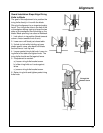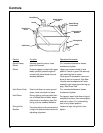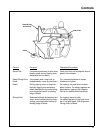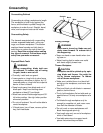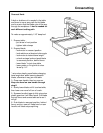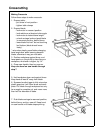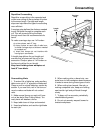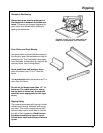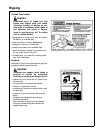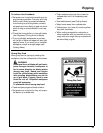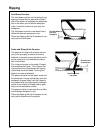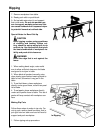
35
Crosscutting
Repetitive Crosscutting
Repetitive crosscutting is the repeated and
continuous cutting of many pieces of lumber
to the same length. Carriage and length
stops can help make this type of crosscutting
more efficient.
A carriage stop defines the distance needed
to pull the blade through to complete each
cut. This will prevent pulling the blade
through more than the recommended dis-
tance.
To make a carriage stop use 1x2 lumber:
a) cut two pieces, each 2" long
b) clamp a piece on each side of radial arm,
so blade carriage stops at distance needed
to complete cut
c) check that clamps do not interfere with
hand grip on saw handle.
A length stop defines the cut length and
ensures that all pieces will be cut to the
same size. Clamp a piece of 1x2 lumber on
the fence to define the cut length.
Keep hand holding down workpiece at
least 8" from blade.
Carriage
Stop
Length
Stop
Crosscutting Hints
1. To extend life of table top, make auxiliary
table cover out of 1/4" plywood or fiberboard.
Clamp or nail to original table top, section by
section. If you use nails, nail in the four cor-
ners to make sure blade will not contact
nails.
2. Make several fences, so each will have
only a few kerfs (See Cutting Aides). Too
many kerfs will weaken a fence.
3. Keep table clean of chips and sawdust.
4. Use sharp blades, and use the right blade
for each job.
5. When making miter or bevel cuts, use
extra force to hold workpiece down because
it tends to move during these types of cuts.
6. When cutting hard woods, like oak, or
making compound cuts, keep arm holding
saw handle rigid and pull blade through
slowly.
7. To keep cut line accurate, periodically
check blade alignment.
8. Do not cut severely warped, bowed or
twisted workpieces.



